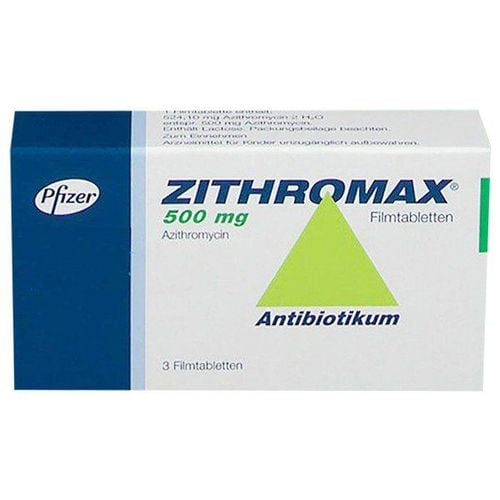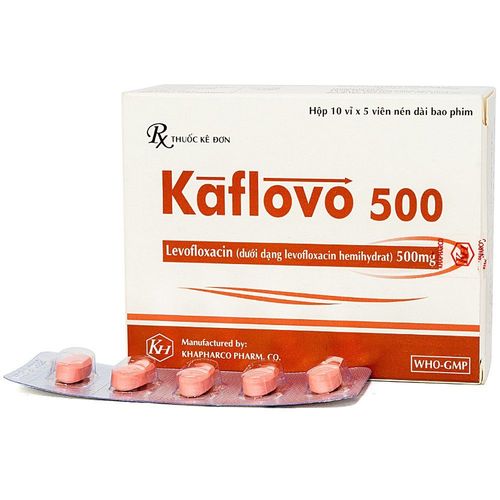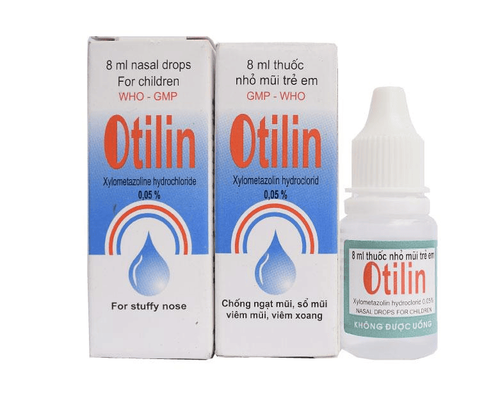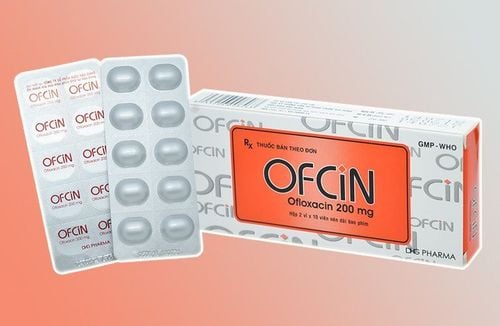This is an automatically translated article.
Levofloxacin SPM 250 is a prescription medicine for the treatment of infections caused by bacteria sensitive to Levofloxacin such as acute sinusitis. Using Levofloxacin SPM 250 exactly as prescribed by a doctor will help patients ensure health safety and maximize the effectiveness of treatment.
1. What are the uses of Levofloxacin SPM 250?
1.1. What is Levofloxacin SPM 250? Levofloxacin SPM 250 belongs to the group of anti-parasitic, anti-infective, anti-viral, anti-fungal drugs, with registration number VD-32215-19, manufactured by SPM Joint Stock Company - Vietnam.
Levofloxacin SPM 250 has the following ingredients:
Main active ingredient: Levofloxacin 250 mg Excipients: Avicel MI 01, Magnesium stearate, Aerosil, Primellose, Talc powder, HPMC 615, HPMC 606, PEG 6000, titanium dioxide , sunset yellow, Ponceau 4R red, kollicoat protect. The drug is prepared in the form of oval red-orange tablets with a notch in the middle with a content of 250mg, blisters of 10 tablets, box of 1 blister.
Levofloxacin SPM 250 is recommended for use in adults.
1.2. What is Levofloxacin SPM 250 used for? Levofloxacin is highly bactericidal. The spectrum of activity includes many bacteria such as:
Aerobic Gram-negative bacteria: Escherichia coli, Klebsiella pneumoniae, Proteus mirabilis, Pseudomonas aeruginosa, Haemophilus influenzae, Haemophilus parainfluenzae, Moraxella catarrhalis, Legionella pneumophila, Enterobacter cloacae, staphylococci, cocci, non-fermentable Gram-negative bacteria. Aerobic Gram-positive bacteria: Staph, methicillin-susceptible aureus, Streptococcus pneumoniae, Streptococcus pyogenes, Streptococcus hemolyticus. Other bacteria: Chlamydia pneumoniae, Mycoplasma pneumoniae. There is cross-resistance between levofloxacin and other fluoroquinolones, and some bacteria resistant to other fluoroquinolones may be susceptible to levofloxacin. Levofloxacin SPM 250 is prescribed by doctors in the following cases:
Community-acquired pneumonia. Skin and soft tissue infections. Urinary tract infections, including pyelonephritis. Chronic prostatitis. Post-exposure prophylaxis and treatment of anthrax. Exacerbation of chronic bronchitis. Acute bacterial sinusitis.
2. Usage of Levofloxacin SPM 250
2.1. How to take Levofloxacin SPM 250 Letrozole Stada 2.5mg is made in the form of tablets that should be taken orally. The drug can be broken in a slit to divide the dose. Drink with a sufficient amount of filtered water. The drug can be taken with a meal or between two meals. Do not break, chew or crush, but swallow the whole tablet. Do not mix the drug with any other mixture. To be sure, carefully read the instructions for use that come with the medicine. 2.2. Dosage of Levofloxacin SPM 250 Acute sinusitis 500 mg/day x 10-14 days. Chronic bronchitis exacerbation 250-500mg/day x 7-10 days. Community-acquired pneumonia 500mg, 1-2 times a day x 7-14 days. Complicated urinary tract infections including pyelonephritis: 250mg/day x 7-10 days. Skin and soft tissue infections 500mg, 1-2 times a day x 7-14 days. Patients with renal impairment (ClCr < 50mL/min): Dosage reduction is required. Handling when missed dose:
Levofloxacin SPM 250mg to treat disease should limit forgetting to take medicine by setting alarm or remembering. If you miss a dose, take Levofloxacin SPM 250 as soon as you remember. However, if the interval between the next dose is too short, skip the missed dose and resume the dosing schedule. Do not take a double dose to make up for a missed dose. Treatment of overdose:
Symptoms: There are no data on levofloxacin overdose in humans. Treatment: in case of acute overdose, empty the stomach by induction of vomiting or gastric lavage. Patients should be monitored and supportive treatment such as renal function checked, oral antacid preparations containing aluminum, magnesium or calcium to reduce absorption of levofloxacin. Adequate fluid should be maintained for the patient. ECG monitoring must be performed because of the potential for prolongation of the QT interval.
3. Contraindications of Levofloxacin SPM 250
Patient is allergic to the main ingredient Letrozole, other quinolones or any of the excipients listed above of Levofloxacin SPM 250. Seizures, G6PD deficiency, history of tendon disease. Children under 18 years old, pregnant women, lactating women.
4. Notes when taking Levofloxacin SPM 250
Serious, potentially irreversible, and disabling adverse reactions, including tendinitis, tendon rupture, peripheral neuropathy, and CNS adverse effects. Discontinue use at the first sign or symptom of any serious adverse reaction. Fluoroquinolone antibiotics (including Levofloxacin) have been associated with potentially fatal and irreversible adverse reactions in various body systems. These reactions may or may not occur simultaneously in the same patient, within a few hours to several weeks after administration of the drug. The most commonly reported adverse reactions include: tendon rupture, tendonitis, myalgia, arthralgia, peripheral neuropathy and CNS adverse effects (anxiety, hallucinations, insomnia, depression, severe headaches and confusion). Patients of any age or without pre-existing risk factors may experience these adverse reactions. Central Nervous System Effects: There have been reports of adverse reactions such as psychosis, increased intracranial pressure, CNS excitation leading to convulsions, tremors, restlessness, headache. , insomnia, depression, confusion, hallucinations, nightmares, suicidal ideation or actions (rare) with the use of quinolone antibiotics, even at the first dose. If these adverse reactions occur while taking Levofloxacin, the drug should be discontinued and appropriate symptomatic management instituted. should be used with caution in patients with central nervous system diseases such as epilepsy, cerebral vascular sclerosis, etc., because it may increase the risk of convulsions. Hypersensitivity Reactions: Hypersensitivity reactions with various clinical manifestations, even anaphylaxis, with the use of Quinolones, including Levofloxacin, have been reported. The drug should be discontinued at the first signs of hypersensitivity reactions and appropriate management measures taken. The drug can cause pseudomembranous colitis due to Clostridium difficile. This adverse reaction has been reported with many antibiotics, including Levofloxacin, which can range in severity from mild to life-threatening. It is important to note the accurate diagnosis of cases of diarrhea occurring while the patient is taking antibiotics to take appropriate measures. Effects on metabolism: As with other quinolones, levofloxacin may cause disturbances of glucose metabolism, including hyperglycemia or hypoglycemia, which commonly occur in diabetic patients receiving levofloxacin concomitantly with an oral hypoglycemic agent. blood or with insulin; Therefore, it is necessary to monitor blood glucose in this patient. If hypoglycemia occurs, levofloxacin should be discontinued and appropriate management measures instituted. Electrocardiogram QT prolongation: Quinolone use may prolong the QT interval on the electrocardiogram in some patients and in rare cases of arrhythmias and should therefore be avoided in patients with a pre-existing prolonged QT interval. long-term, patients with hypokalemia, patients who are using class IA or class III antiarrhythmic drugs; Levofloxacin should be used with caution in patients with prearrhythmic conditions such as bradycardia and acute myocardial ischemia. Excipient warning: This medicine contains sunset yellow and ponceau red 4R excipients which may cause allergic reactions.
5. Interactions with other drugs
Effects of other drugs on oral levofloxacin:
Zinc salts, iron salts, antacids containing magnesium or aluminum reduce the absorption of levofloxacin when taken concomitantly. It is not recommended to take 2 hours before or after taking Levofloxacin SPM 250. Co-administration of fluoroquinolones with zinc-containing multivitamins reduces oral absorption. Sucralfate: Decreases the bioavailability of oral Levofloxacin when co-administered with Sucralfate. If the patient must take both sucralfate and levofloxacin, it is best to take sucralfate 2 hours after levofloxacin. Theophylline, Fenbufen or similar non-steroidal anti-inflammatory drugs: Increases absorption of Levofloxacin SPM 250 when taken together. Probenecid and Cimetidine: Probenecid and Cimetidine were statistically significantly effective on the elimination of Levofloxacin. Therefore, caution should be exercised when Levofloxacin is co-administered with drugs affecting renal tubular secretion such as probenecid and cimetidine, especially in patients with renal impairment. Clinical pharmacology studies have shown that the pharmacokinetics of Levofloxacin are not affected when the following drugs are co-administered: Digoxin, Calcium Carbonate, Glibenclamide, Ranitidine. Effect of levofloxacin on other drugs:
Ciclosporin: Increases the half-life of cyclosporin by 33% when co-administered with Levofloxacin.
Vitamin K Antagonists: Increased coagulation test indices (PT/INR) and/or bleeding have been reported in patients treated with levofloxacin in combination with vitamin K antagonists (eg. Warfarin). Therefore, coagulation tests should be monitored in patients treated with vitamin K antagonists.
Drugs known to prolong the QT interval: Levofloxacin, like other fluoroquinolones, must be used with caution in patients taking drugs known to prolong the QT interval (eg, class IA and III antiarrhythmics, tricyclic antidepressants, macrolides, sedatives).
Hypoglycemic agents: Concomitant use with Levofloxacin may increase the risk of blood sugar disturbances, close monitoring is required.
6. Side effects of Levofloxacin SPM 250
Common:
Gastrointestinal: Nausea, vomiting, diarrhea, abdominal pain, constipation, dyspepsia. Liver: Increases liver enzymes. Nervous: Insomnia, headache. Uncommon:
Nervous: Dizziness, nervousness, agitation, anxiety. Gastrointestinal: Abdominal pain, flatulence, dyspepsia, vomiting, constipation. Liver: Hyperbilirubinemia. Urogenital, genitourinary: Vaginitis, genital candidiasis. Skin: Itching, rash. Rare:
Cardiovascular: Increase or decrease in blood pressure, arrhythmia. Musculoskeletal: Myalgia, arthralgia, muscle weakness, osteomyelitis, Achilles tendonitis. Gastrointestinal: Pseudomembranous colitis, dry mouth, gastritis, tongue edema. Neurological: Convulsions, abnormal dreams, depression, psychosis. Allergies: Quincke's edema, anaphylaxis, Stevens-Johnson syndrome and Lyell syndrome. Instructions for the management of ADR:
Levofloxacin should be discontinued in the following cases: Initiation of skin rash or any other sign of hypersensitivity or CNS adverse reactions. Patients should be carefully monitored for pseudomembranous colitis and appropriately managed when diarrhea occurs while taking levofloxacin. When signs of tendinitis appear, the drug should be stopped immediately, let the two tendons rest with appropriate immobilizers or heel braces and consult a specialist.
7. How to store Levofloxacin SPM 250
Keep the medicine in its original packaging, in a dry room, away from sunlight. The temperature should not exceed 30°C. Keep out of reach of children and pets. The basic information about Levofloxacin SPM 250 in the above article is for reference only. Because this is a prescription drug, patients should not use it on their own, but need to contact a specialist directly to get an appropriate prescription to ensure safety for health.













